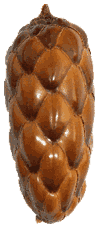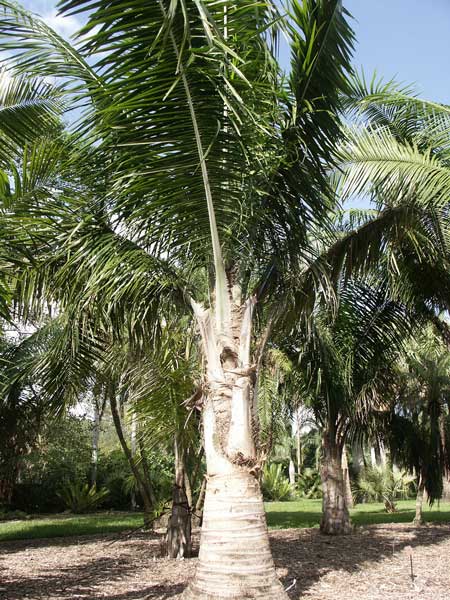 |
Palm |
 |
Palm |
Attalea crassispatha is endemic to the southern peninsula of Haiti, where approximately 25–30 individual palms are thought to survive. It is the only member of the subtribe Attaleinae native to the Greater Antilles. The species is restricted to four localities within two major watersheds, the Cavaillon and Côtes-de-Fer, where it grows from sea level to 450 m in elevation.
Attalea crassispatha (Mart.) Burret is a tall (to 20 m), solitary palm bearing a dense crown of pinnate leaves, each leaf up to 5 m long and bearing up to 165 pairs of leaflets. Overall, the palm can resemble a robust coconut palm. The inflorescence bears a thick, woody, furrowed peduncular bract. The staminate flowers bear three lance-shaped petals that are not fused together at their bases and eight or nine stamens. The anthers are curled and shorter than the petals. The fruits are egg-shaped, ca. 3 cm long. Each fruit has a hard stone (endocarp) enclosing a single seed.
The palm is used locally as a natural boundary marker or landmark. Children eat the soft, immature endosperm of the seeds. The immature endosperm has a flavor similar to coconut.
Little is known of the natural history of Attalea crassispatha, as so much of its natural habitat has been altered by grazing livestock, fire and farming. Its natural habitat is seasonally dry forest, but much of the forest cover is now absent. Nevertheless, Attalea crassispatha persists and can reproduce in anthropomorphic habitats, if given an opportunity.
Most adult palms currently occur as isolated individuals. Aspects of their biotic interactions are unknown.
 |
| Attalea crassispatha growing in an ex situ collection at Fairchild Tropical Botanic Garden, Miami, Florida, USA. |
Habitat destruction has had a significant impact on this species. It is likely that changes in forest cover, soil structure and moisture, fire regime, and abundance of native seed dispersal agents have had a negative effect on the natural reproduction of this palm. Regeneration is prevented by livestock grazing on fruits and seedlings and by people, who harvest immature seeds as snacks. Periodic hurricanes, to which the area is prone, are also a threat to the remaining adult palms of this species. A mature individual was toppled by Hurricane Georges in 1998.
A large ex situ population of Attalea crassispatha is maintained at Fairchild Tropical Botanic Garden, Miami, Florida, USA. It is probably the largest collection of the species in the world. Most of the palms are still too young to flower or fruit. Seeds were also distributed to other botanical gardens in the USA, Central America, and elsewhere.
In Haiti, seedlings of Attalea crassispatha were planted on the grounds of public buildings and private residences in 1990, in an effort to develop in-country ex situ collections. Additionally, families with Attalea crassispatha growing on their land were paid to preserve the palm. It is not known if the payments have been sustained.
A local NGO, the Fondation Botanique d'Haiti is undertaking a two-year project to investigate the distribution, ecology and conservation status of Attalea crassispatha, with support from Flora & Fauna International. The project will conduct public awareness activities, propagate and distribute of seedlings for out-planting
Additional field work is needed to determine the full area of occupancy of this species. The rugged back country, away from farms and villages, may yield additional individuals of Attalea crassispatha.
Assessing the individuals outplanted in Haiti, along with those for whom land owners were paid to maintain, is necessary. Given the social and political unrest in recent years in Haiti, land owners and caretakers may have abandon efforts to conserve the palm. The fate of the remaining palms in Haiti is unknown.
The ex situ collection at Fairchild Tropical Botanic Garden is probably the best germplasm preserve for this rare species. A very few individuals are reproductively mature, but fruits with viable seeds have not been produced on the mature palms. Research is needed to determine if reproductive failure is due to lack of pollination, sterility or incompatibility, pests, or other causes. As other species of Attalea are grown at FTBG, future offspring from fruiting Attalea crassispatha may prove to be hybrids. Additional research will be needed to determine if seeds produced from the ex situ collection at FTBG are “pure.”
Dr. Scott Zona, FTBG
References
Global Trees Campaign.
Carossier palm.
Henderson, A. & M. Aubry. 1989.
Attalea crassispatha, an endemic and endangered Haitian palm.
Principes 33: 88–90.
Henderson, A. & M. Balik. 1991.
Attalea crassispatha, a rare and endemic Haitian palm.
Brittonia 43: 189–194.
Timyan, J. C. & S. F. Reep. 1999.
Conservation status of Attalea crassispatha (Mart.) Burret, the rare and endemic oil palm of Haiti.
Biol. Conserv. 68: 11–18.